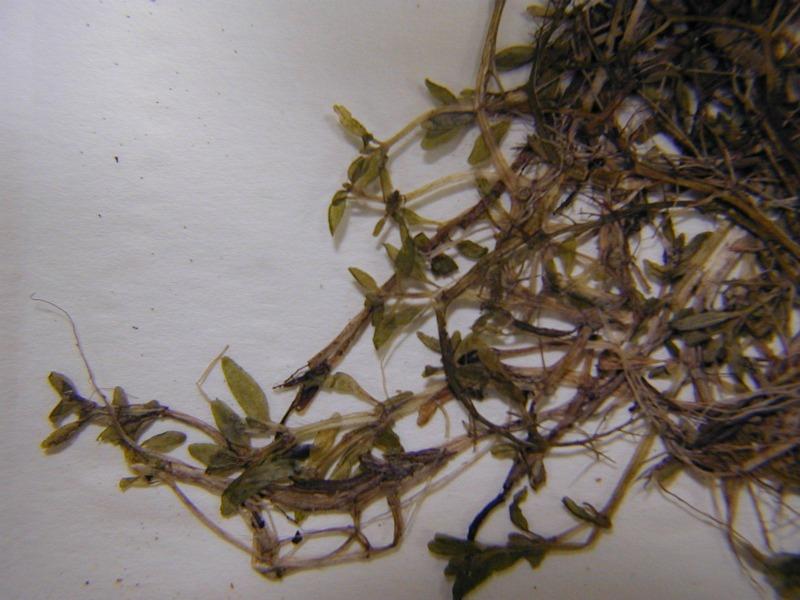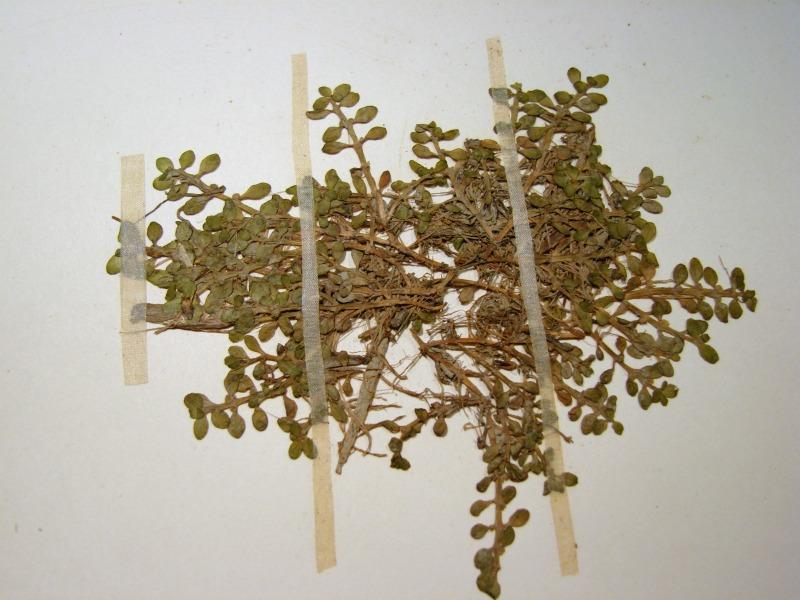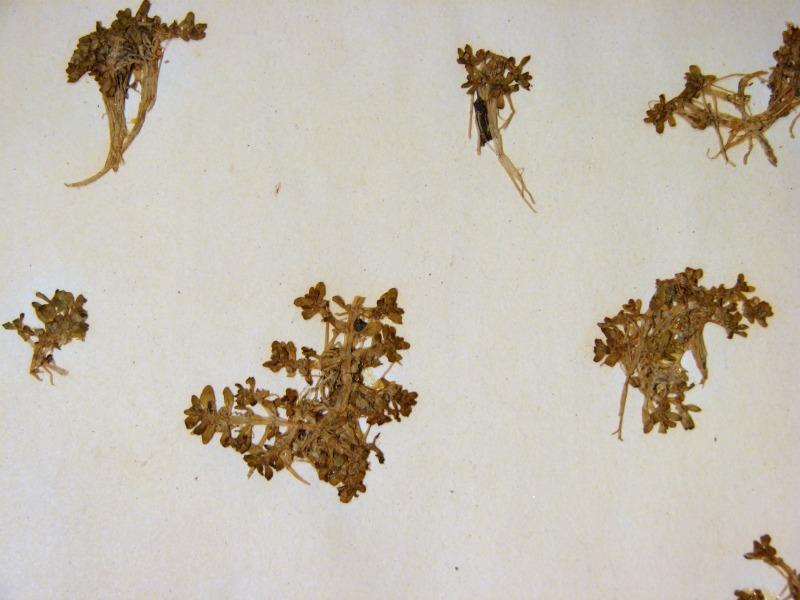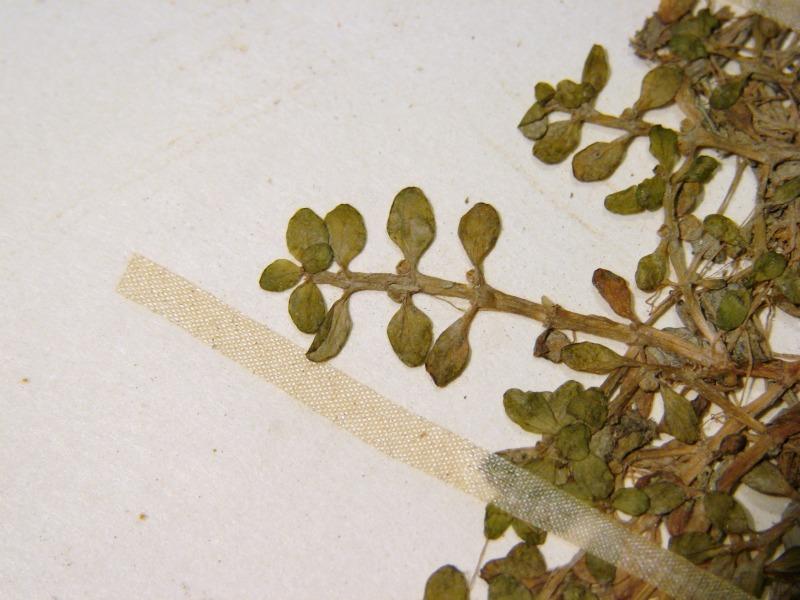American Waterwort
Elatine americana (Pursh) Arn.
- Class
- Dicotyledoneae (Dicots)
- Family
- Elatinaceae (Waterwort Family)
- State Protection
- Endangered
Listed as Endangered by New York State: in imminent danger of extirpation in New York. For animals, taking, importation, transportation, or possession is prohibited, except under license or permit. For plants, removal or damage without the consent of the landowner is prohibited.
- Federal Protection
- Not Listed
- State Conservation Status Rank
- S1
Critically Imperiled in New York - Especially vulnerable to disappearing from New York due to extreme rarity or other factors; typically 5 or fewer populations or locations in New York, very few individuals, very restricted range, very few remaining acres (or miles of stream), and/or very steep declines.
- Global Conservation Status Rank
- G4
Apparently Secure globally - Uncommon in the world but not rare; usually widespread, but may be rare in some parts of its range; possibly some cause for long-term concern due to declines or other factors.
Summary
Did you know?
In a state-sponsored survey of the plants of the tidal Hudson River in the mid-1930s this plant was found at many of the mud flats along the river. Today it is only known from one of them. The genus name comes from the Greek word "elatinos" meaning "of the fir". It was used by Pliny to refer to a plant of the genus Antirrhinum in the Snapdragon family. The pronunciation of the genus "ella-tiny" is pertinent since the plant is indeed very tiny and can be overlooked.
State Ranking Justification
There are two existing occurrences which are very small and contain less than 100 plants total. There are 18 historical occurrences, mostly from the Hudson River from the 1930s. A few are also scattered on Long Island.
Short-term Trends
The short-term trend is unclear because the two existing populations have not been resurveyed in recent years.
Long-term Trends
This species may have never been common in New York. Most of the historical records were found during surveys of the Hudson River during the 1930s but none of them have been rediscovered. The two existing populations are very small. With more surveys we may obtain more understanding of the fluctuations in long-term and short-term trends.
Conservation and Management
Threats
These plants occur in unstable habitat on shorelines of rivers and ponds and changes in hydrology, vegetation, erosion rates, or shoreline use could threaten them.
Conservation Strategies and Management Practices
It is unclear what specific management techniques are required to protect this plant. Its open, wet habitat needs to be maintained and protected from succession or direct human use.
Research Needs
Research is needed to study the habitat preference of this plant because it occurs in a habitat that seems common in the state. What limits its distribution in this common habitat?
Habitat
Habitat
In New York American Waterwort occupies intertidal mudflats and marshes along the Hudson River, and historically was also collected from kettle holes on the coastal plain (New York Natural Heritage Program 2007). Muddy tidal shores and margins of ponds and streams (Fernald 1970). Muddy tidal shores (Gleason 1952).
Associated Ecological Communities
- Brackish intertidal mudflats*
(guide)
A sparsely vegetated community, characterized by low-growing, rosette-leaved aquatics. The community occurs on exposed intertidal mudflats where water salinity ranges from 0.5 to 18.0 ppt. This community is best developed where mudflats are nearly level so that broad expanses are exposed at low tide. The rosette-leaved aquatics are completely submerged at high tide, and they are usually coated with mud.
- Brackish tidal marsh*
(guide)
A marsh community that occurs where water salinity ranges from 0.5 to 18.0 ppt, and water is less than 2 m (6 ft) deep at high tide. The vegetation in a brackish tidal marsh is dense and dominated by tall grass-like plants.
- Freshwater intertidal mudflats
(guide)
A sparsely vegetated community characterized by low rosette-leaved aquatics. This community occurs on exposed intertidal mudflats where the water is fresh (salinity less than 0.5 ppt). This community is best developed where mudflats are nearly level so that broad expanses are exposed at low tide. The plants are completely submerged in 0.9 to 1.2 m (3 to 4 ft) of water at high tide and they are usually coated with mud.
* probable association but not confirmed.
Associated Species
- Heteranthera dubia (water star-grass)
- Sagittaria montevidensis
- Sagittaria subulata (awl-leaved arrowhead)
Range
New York State Distribution
In New York water starwort is known from Long Island and the tidally-influenced portion of the Hudson River, as far north as Rennsalaer County.
Global Distribution
American Waterwort is found from Quebec and Newfoundland in the northeast south through most of the Atlantic and Gulf states to Louisiana, and scattered across the western states to Montana and New Mexico, and as far as Manitoba in the north.
Identification Comments
General Description
American waterwort is a tiny creeping or floating annual herb. Its leaves are are obovate and just 3-8 mm long and 1.5 -5 mm broad. The flowers are 3-parted and borne in the leaf axils, and the fruit are capsules.
Best Life Stage for Proper Identification
American waterwort is most easily identified when in fruit.
Similar Species
Gratiola aurea and G. virginiana have broad-based sessile leaves, bright yellow petals, and a capsules on a long stalk. Callitriche spp. have widely-spaced, fleshy leaves, unisexual flowers with no perianth, and 2-lobed fruit. Ludwigia palustris has longer (1-4 cm) petioles and a sessile, 4-sided capsule. Tillaea aquatica has flowers that are sessile in the leaf axils, and its leaves are succulent, narrow, and 2-7 mm long. Lindernia dubia has toothed or entire leaves that are 1-3 cm long.
Among the other two waterwort species in the state, Elatine minima can be distinguished from E. americana by its 2-parted flowers, leaves rarely over 4 mm long, and basal axile seeds, and Elatine triandra by its linear to spatulate leaves.
Best Time to See
This species flowers from mid-July to mid-August, and the fruits persist into mid-October.
- Flowering
- Fruiting
The time of year you would expect to find American Waterwort flowering and fruiting in New York.
American Waterwort Images
Taxonomy
American Waterwort
Elatine americana (Pursh) Arn.
- Kingdom Plantae
- Phylum Anthophyta
- Class Dicotyledoneae
(Dicots)
- Order Theales
- Family Elatinaceae (Waterwort Family)
- Order Theales
- Class Dicotyledoneae
(Dicots)
- Phylum Anthophyta
Additional Common Names
- Water Purslane
Synonyms
- Elatine triandra var. americana (Pursh)Fassett
Additional Resources
Best Identification Reference
Crow, Garrett E. and C. Barre Hellquist. 2000. Aquatic and Wetland Plants of Northeastern North America: A revised and enlarged edition of Norman C. Fassett's a Manual of Aquatic Plants. Volume One: Pteridophytes, Gymnosperms, and Angiosperms: Dicotyledons. The University of Wisconsin Press. Madison, Wisconsin. 536 Pages.
Other References
Borman, Susan, Robert Korth and Jo Temte. 1997. Through the Looking Glass. A Field Guide to Aquatic Plants. Wisconsin Lakes Partnership, University of Wisconsin - Stevens Point, Stevens Point, Wisconsin.
Fernald, M.L. 1950. Gray's manual of botany. 8th edition. D. Van Nostrand, New York. 1632 pp.
Gleason, Henry A. and A. Cronquist. 1991. Manual of Vascular Plants of Northeastern United States and Adjacent Canada. The New York Botanical Garden, Bronx, New York. 910 pp.
Haines, Arthur and Thomas F. Vining. 1998. Flora of Maine. A Manual for Identification of Native and Naturalized Vascular Plants of Maine.
Holmgren, Noel. 1998. The Illustrated Companion to Gleason and Cronquist's Manual. Illustrations of the Vascular Plants of Northeastern United States and Adjacent Canada. The New York Botanical Garden, Bronx, New York.
New York Natural Heritage Program. 2010. Biotics database. New York Natural Heritage Program. New York State Department of Environmental Conservation. Albany, NY.
New York Natural Heritage Program. 2024. New York Natural Heritage Program Databases. Albany, NY.
Rhoads, Ann F. and Timothy A. Block. 2000. The Plants of Pennsylvania, an Illustrated Manual. University of Pennsylvania Press, Philadelphia, PA.
Weldy, T. and D. Werier. 2010. New York flora atlas. [S.M. Landry, K.N. Campbell, and L.D. Mabe (original application development), Florida Center for Community Design and Research http://www.fccdr.usf.edu/. University of South Florida http://www.usf.edu/]. New York Flora Association http://newyork.plantatlas.usf.edu/, Albany, New York
Weldy, Troy W. and David Werier. 2005. New York Flora Atlas. [S.M. Landry, K.N. Campbell, and L.D. Mabe (original application development), Florida Center for Community Design and Research. University of South Florida]. New York Flora Association, Albany, NY. Available on the web at (http://newyork.plantatlas.usf.edu/).
Links
About This Guide
Information for this guide was last updated on: January 18, 2008
Please cite this page as:
New York Natural Heritage Program. 2024.
Online Conservation Guide for
Elatine americana.
Available from: https://guides.nynhp.org/american-waterwort/.
Accessed July 26, 2024.




